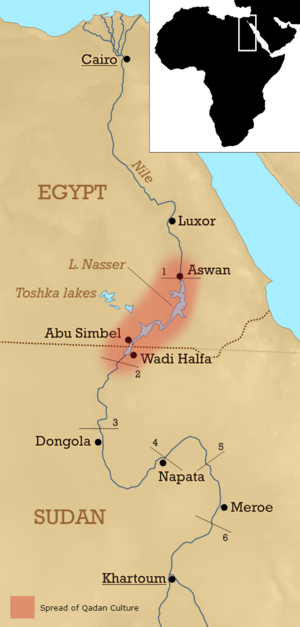ثقافة قادان
 | |
| النطاق الجغرافي | Upper Egypt |
|---|---|
| الفترة | Mesolithic |
| التواريخ | 15,000 BP — 11,000 BP |
| المواقع الرئيسية | Cemetery 117 |
| سبقها | Sebilian |
| تلاها | Harifian |
| العصر الحجري القديم |
|---|
| ↑ پليوسين (قبل هومو) |
| ↓ العصر الحجري الوسيط |
The Qadan culture (13,000-9,000 BC) was an ancient culture that, archaeological evidence suggests, originated in Upper Egypt (present day south Egypt) approximately 15,000 years ago.[1][2] This way of life is estimated to have persisted for approximately 4,000 years, and was characterized by hunting, as well as a unique approach to food gathering that incorporated the preparation and consumption of wild grasses and grains.[1][2] Systematic efforts were made by the Qadan people to water, care for, and harvest local plant life, but grains were not planted in ordered rows.[3]
Sites from this period span from the Second Cataract of the Nile to Tushka, situated approximately 250 kilometers upriver from Aswan.[4]
In archaeological terms, the Qadan culture is generally viewed as a cluster of Mesolithic Stage communities living in Nubia in the upper Nile Valley prior to 9000 BC. At a time of relatively high water levels in the Nile, it is characterized by a diverse stone tool industry that is taken to represent increasing degrees of specialization and locally differentiated regional groupings.[3] Large numbers of grinding stones and blades have been found with glossy films of silica on them, which could possibly be the result of cutting grass stems on their surfaces.[بحاجة لمصدر] There is some evidence of conflict between the groups, suggesting periods of invasion or intense inter-tribal war.[3] In fact, about 40 percent of individuals buried in the Jebel Sahaba cemetery near the border of Sudan on the Nile river show signs of fatal wounds caused by projectiles,[4] from weapons such as spears, darts, or arrows.[بحاجة لمصدر] The remains found in the cemeteries suggest that ritual burials were practiced.[بحاجة لمصدر]
The Qadan economy was based on fishing, hunting, and, as mentioned, the extensive use of wild grain.[3]
المراجع
- ^ أ ب Phillipson, DW: African Archaeology page 149. Cambridge University Press, 2005.
- ^ أ ب Shaw, I & Jameson, R: A Dictionary of Archaeology, page 136. Blackwell Publishers Ltd, 2002.
- ^ أ ب ت ث Darvill, T: The Concise Oxford Dictionary of Archaeology, Copyright © 2002, 2003 by Oxford University Press.
- ^ أ ب Facts On File, Incorporated (2009). Encyclopedia of the Peoples of Africa and the Middle East. Infobase Publishing. p. 777.
| هذا article relating to anthropology هو بذرة. بإمكانك مساعدة المعرفة بأن تنمـِّـيـه. |